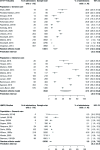Incidence and characteristics of adverse events in paediatric inpatient care: a systematic review and meta-analysis
- PMID: 36572528
- PMCID: PMC9985739
- DOI: 10.1136/bmjqs-2022-015298
Incidence and characteristics of adverse events in paediatric inpatient care: a systematic review and meta-analysis
Abstract
Background: Adverse events (AEs) cause suffering for hospitalised children, a fragile patient group where the delivery of adequate timely care is of great importance.
Objective: To report the incidence and characteristics of AEs, in paediatric inpatient care, as detected with the Global Trigger Tool (GTT), the Trigger Tool (TT) or the Harvard Medical Practice Study (HMPS) method.
Method: MEDLINE, Embase, Web of Science and Google Scholar were searched from inception to June 2021, without language restrictions. Studies using manual record review were included if paediatric data were reported separately. We excluded studies reporting: AEs for a specific disease/diagnosis/treatment/procedure, or deceased patients; study protocols with no AE outcomes; conference abstracts, editorials and systematic reviews; clinical incident reports as the primary data source; and studies focusing on specific AEs only. Methodological risk of bias was assessed using a tool based on the Quality Assessment Tool for Diagnostic Accuracy Studies 2. Primary outcome was the percentage of admissions with ≥1 AEs. All statistical analyses were stratified by record review methodology (GTT/TT or HMPS) and by type of population. Meta-analyses, applying random-effects models, were carried out. The variability of the pooled estimates was characterised by 95% prediction intervals (PIs).
Results: We included 32 studies from 44 publications, conducted in 15 countries totalling 33 873 paediatric admissions. The total number of AEs identified was 8577. The most common types of AEs were nosocomial infections (range, 6.8%-59.6%) for the general care population and pulmonary-related (10.5%-36.7%) for intensive care. The reported incidence rates were highly heterogeneous. The PIs for the primary outcome were 3.8%-53.8% and 6.9%-91.6% for GTT/TT studies (general and intensive care population). The equivalent PI was 0.3%-33.7% for HMPS studies (general care). The PIs for preventable AEs were 7.4%-96.2% and 4.5%-98.9% for GTT/TT studies (general and intensive care population) and 10.4%-91.8% for HMPS studies (general care). The quality assessment indicated several methodological concerns regarding the included studies.
Conclusion: The reported incidence of AEs is highly variable in paediatric inpatient care research, and it is not possible to estimate a reliable single rate. Poor reporting standards and methodological differences hinder the comparison of study results.
Keywords: Adverse events, epidemiology and detection; Chart review methodologies; Paediatrics; Trigger tools.
© Author(s) (or their employer(s)) 2023. Re-use permitted under CC BY-NC. No commercial re-use. See rights and permissions. Published by BMJ.
Conflict of interest statement
Competing interests: None declared.
Figures

Comment in
-
Imperfection in adverse event detection: is this the opportunity to mature our focus on preventing harm in paediatrics?BMJ Qual Saf. 2023 Aug;32(8):431-434. doi: 10.1136/bmjqs-2022-015776. Epub 2023 May 4. BMJ Qual Saf. 2023. PMID: 37142413 No abstract available.
References
-
- Kohn LT, Corrigan JM, Donaldson MS. To err is human: building a safer health system. Washington (DC): Institute of Medicine Committee on Quality of Health Care in, America, 1999.
-
- World Health Organisation . World Alliance for patient safety: forward programme 2005 France, 2004. Available: https://apps.who.int/iris/handle/10665/43072
-
- Griffin F, Resar R. IHI global trigger tool for measuring adverse events (second edition. Cambridge, Massachusetts: Instutute for Healthcare Improvment, 2009.
Publication types
MeSH terms
LinkOut - more resources
Full Text Sources
Medical
Research Materials
Miscellaneous
